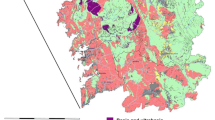Abstract
Artesian basins contain the largest mineral water resources of the world. There are several types of mineral therapeutic water: sulfate, chloride, radon-rich, iron-rich waters, etc. Artesian basins occupy very large areas in Russia. However, genesis of water and brines is still not very clear. This is one of the most important hydrogeological problems that is being attempted to solve for many years. Most of the Russian hydrogeologists traditionally consider that these waters are of sedimentary origin. However, higher concentrations of bromine, iodine, iron, radon and other balneologically active components can be of different origin, for example, of infiltration or juvenile water. As an example, two areas will be considered – West-Siberian basin and East-European artesian area.
West-Siberian artesian basin has very distinct latitudinal and vertical zonation. Latitudinal zonation is caused by climate changes from north to south. As for the vertical zonation, mineralization and chemical composition change in the vertical cross-section and from the periphery to the center within the same aquifer. The main mineral water resources of West-Siberian artesian basin are concentrated in Mesozoic rocks. Brackish waters and low-saturated brines without specific components are used for medical purposes. The most well-known spa is Karachi, which exploits chloride-hydrocarbonate brackish water. Sodium chloride bromine and iodine-bromine waters are used at other health resorts. It is possible to organize extraction of iodine from brines of Tcherkashinsko-Tobolskoe occurrence in Tumen region.
East-European artesian area occupies most of the Russian Platform. The most widespread types of mineral water within the Russian Platform are sodium-chloride and magnesium-sulfate waters and brines. Such well-known spas, like Moscow mineral waters, Krainka, Staraya Russa and many others, belong to this type. Resources of these waters are definitely connected with sedimentogenic processes. The upper hydrodynamic zone contains iron-rich, hydrogen sulfide, and sometimes radon-rich water. Their formation is caused by the interaction between waters of infiltration and sedimentary genesis, or between infiltration waters and host rocks. One of the examples is Polustrovo iron-rich water. There are industrially valuable waters containing bromine and iodine.
The resources of therapeutic water of sedimentary basins allow to increase balneological potential of spas in Russia.



Similar content being viewed by others
References
Pinneker EV (ed) (1980) Fundamentals of Hydrogeology: Groundwater use and protection. Novosibirsk, “Nauka” (In Russian)
Plotnikova RI, Soustova TN (1998) Mineral raw materials. Mineral groundwaters Handbook. Moscow, “Geoinformmark”, 57 pp (In Russian)
Zaytsev IK, Tolstikhin NI (1972) Regularities of spreading and formation of mineral (industrially valuable and medicinal) groundwater on the territory of the USSR. Moscow, “Nedra”, 280 pp (In Russian)
Author information
Authors and Affiliations
Corresponding author
Rights and permissions
About this article
Cite this article
Vinograd, N.A. Formation of mineral and thermal waters of some artesian basins in Russia. Env Geol 46, 675–679 (2004). https://doi.org/10.1007/s00254-004-1007-2
Received:
Accepted:
Published:
Issue Date:
DOI: https://doi.org/10.1007/s00254-004-1007-2




